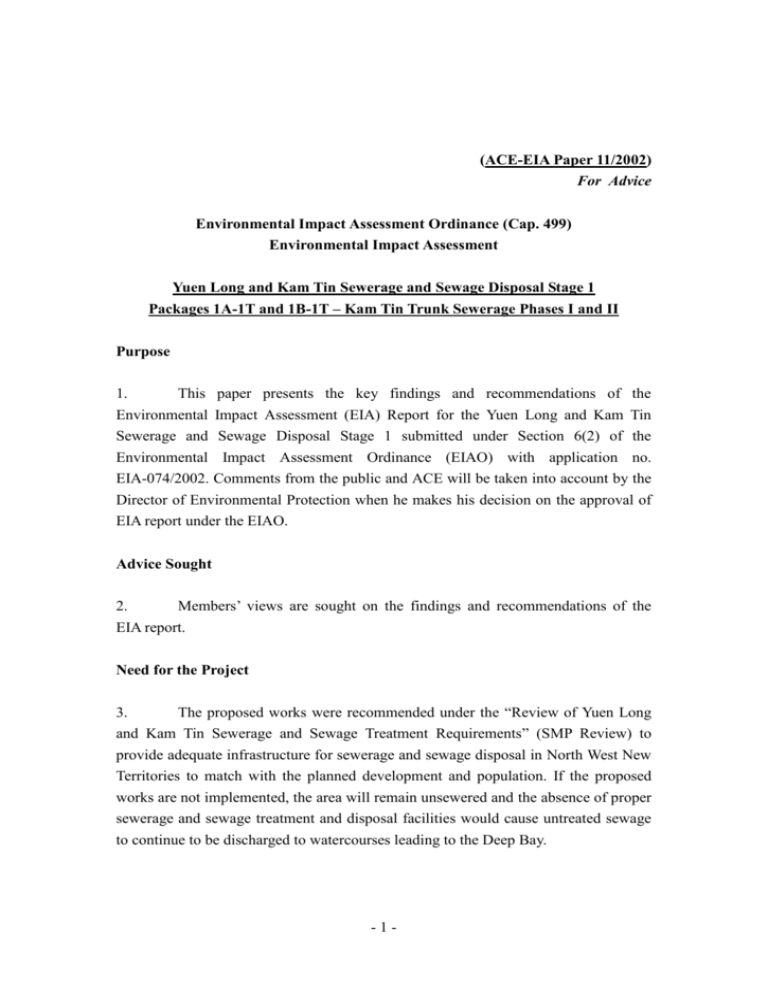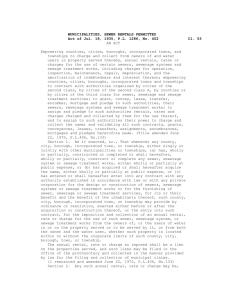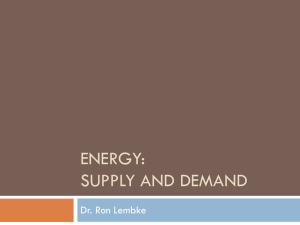Yuen Long and Kam Tin Sewerage and Sewage Disposal Stage 1
advertisement

(ACE-EIA Paper 11/2002) For Advice Environmental Impact Assessment Ordinance (Cap. 499) Environmental Impact Assessment Yuen Long and Kam Tin Sewerage and Sewage Disposal Stage 1 Packages 1A-1T and 1B-1T – Kam Tin Trunk Sewerage Phases I and II Purpose 1. This paper presents the key findings and recommendations of the Environmental Impact Assessment (EIA) Report for the Yuen Long and Kam Tin Sewerage and Sewage Disposal Stage 1 submitted under Section 6(2) of the Environmental Impact Assessment Ordinance (EIAO) with application no. EIA-074/2002. Comments from the public and ACE will be taken into account by the Director of Environmental Protection when he makes his decision on the approval of EIA report under the EIAO. Advice Sought 2. Members’ views are sought on the findings and recommendations of the EIA report. Need for the Project 3. The proposed works were recommended under the “Review of Yuen Long and Kam Tin Sewerage and Sewage Treatment Requirements” (SMP Review) to provide adequate infrastructure for sewerage and sewage disposal in North West New Territories to match with the planned development and population. If the proposed works are not implemented, the area will remain unsewered and the absence of proper sewerage and sewage treatment and disposal facilities would cause untreated sewage to continue to be discharged to watercourses leading to the Deep Bay. -1- Description of the Project 4. The project includes construction of trunk sewers/rising associated pumping stations to transfer sewage from the Kam Tin Core Yuen Long Sewage Treatment Works. The total length of sewers/rising constructed is approximately 10km and the majority of which will be along the maintenance access road of the Kam Tin MDC. mains and Area to the mains to be constructed 5. Two elements of the Project, namely S4 and S6 as shown on Figure 1, fall within a Conservation Area and thus, constitute Designated Projects under Item Q.1 of the EIAO (i.e. All projects including new access roads, railways, sewers, sewage treatment facilities earthworks, dredging works and other building works partly or wholly in an existing or gazetted proposed country park or special area, a conservation area, an existing or gazetted proposed marine park or marine reserve, a site of cultural heritage, and a site of special scientific interest”). Specific Environmental Aspects to Highlight 6. The key environmental impacts identified are ecological, water quality and construction noise impact. Ecological Impacts 7. The proposed sewer alignment and pumping station sites are mainly located on existing roads/footpaths, which are classified as urbanised/disturbed habitats of minimal ecological value. The EIA report identified that there will only be a direct loss of 0.15 ha of abandoned fishpond of low ecological value and other low quality habitats outside the Wetland Conservation Area (WCA) and Wetland Buffer Area (WBA). 8. Regarding the indirect impact within the WCA and WBA, mitigation measures including prohibition of construction activities during winter season (November to March) for the section of the sewerage alignment as indicated in Figure 1, use of pipe jacking method, quietened construction plant and equipments, erection of fencing, silt removal facilities and prohibition of open fires within the site boundary. -2- 9. With the implementation of the mitigation measures, the EIA report concluded that no adverse direct or indirect residual impact is anticipated during the construction and operation of the sewerage system and pumping stations. Water Quality Impact 10. For water quality impact during operation, an assessment of the impacts of the project on inland water quality determined that there would be a 10% reduction in polluting discharges and that there would therefore be an improvement in water quality. 11. For construction water quality impacts, as the majority of construction of sewers/rising mains and pumping stations will be land based activities. Construction activities across the main drainage channel will use the pipe jacking method i.e. boring a tunnel for the sewers underneath the river bed of the MDC. Unlike the conventional dredging method for laying the sewers, this method will avoid the release of river sediments under normal operating conditions. Hence, the EIA report envisaged that no adverse water quality impacts would arise with the implementation of the recommended mitigation measures. Construction Noise 12. To mitigate the construction noise impacts, measures such as quiet plant, movable noise barrier and limiting the use of powered mechanical equipment (PME) are recommended in the EIA report. To further reduce the potential noise impacts at the nearby noise sensitive receivers, the use of handheld breakers instead of excavated mounted breakers together with the use of movable noise barriers and/ or enclosures is recommended during the noisy construction activities i.e. road opening. 13. It is anticipated that the sewers will be constructed in segments of up to 50m in length and noise exceedances of up to 6dB(A) may arise on isolated occasions. Exceedances of up to 12dB(A) are predicted during the reinstatement works at one location for 2 –3 days. In view of the close proximity of some NSRs to the work site, noise exceedances are anticipated even with the adoption of all practical mitigation measures. The EIA report recommended regular noise monitoring during construction phase at noise sensitive receivers. -3- Environmental Monitoring and Audit (EM&A) 14. An EM&A programme has been proposed in the EM&A Manual submitted together with the EIA report and included a detailed Implementation Schedule. For those designated elements, the EM&A requirements will be enforced as Environmental Permit conditions. Public Consultation 15. DSD has made the EIA report, EM&A Manual and Executive Summary available for the public to comment under the EIAO on 11 June 2002. Members will be briefed about any comments received from the public at the meeting. Environmental Assessment and Noise Division Environmental Protection Department June 2002 -4- -5-







